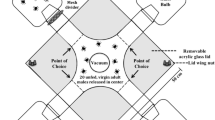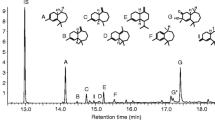Abstract
The responses of scapularis (Acari: Ixodidae) nymphs and adults to extracts of cast larval skins were tested in a Petri dish bioassay. Assembly was elicited in nymphs and adults in the presence of skins, exudate from ticks, and filter paper exposed to ticks compared to untreated controls. Assembly was noted by 1 hr after exposure with little change between 1 and 24 hr. The assembly response increased in the presence of an increased number of skins. Similar assembly was elicited in nymphs and adults in the presence of cast larval skins and a saline (0.95% NaCl) skin extract. Methanol and hexane extracts were not attractive. When chemical standards were tested against nymphs, they responded to guanine, uric acid, hypoxanthine, xanthine, inosine, and hematin. Adults were tested against guanine, inosine, and xanthine, and all elicited significant assembly. Responses of nymphs increased significantly with increase in dose of uric acid and guanine. Responses of nymphs to a mixture of guanine, xanthine, and adenine (25:1:1 ratio) were similar to responses to cast skins. This study provides the first evidence of an assembly pheromone in I. scapularis.
Similar content being viewed by others
REFERENCES
Arlian, L. G. and Vyszenski-Moher, A. 1996. Responses of Sarcoptes scabei (Acari: Sarcoptidae) to nitrogenous waste and phenolic compounds. J. Med. Entomol. 33:236–243.
Carroll, M. C., Ginsberg, H. S., Hyland, K. E., and Hu, R. 1992. Distribution of Ixodes dammini (Acari: Ixodidae) in residential lawns on Prudence Island, Rhode Island. J. Med. Entomol. 29:1052–1055.
Childs, J., Shope, R. E., Fish, D., Meslin, F. X., Peters, C. J., Johnson, K., Debess, E., Dennis, D., and Jenkins, S. 1998. Emerging zoonoses. Emerging Infect. Dis. 4:453–454.
Dobrotvorskii, A. K., Tkachev, A. V., and Pankrushina, N. A. 1991. Attracting effect of excreta on unfed adult ticks Ixodes persulcatus P. Sch. (Acarina: Ixodoidea). Izv. Sib. Otd. Akad. Nauk SSSR Ser. Biol. Nauk 0:81–86.
DusbÁbek, F., Šimek, P., Jegorov, A., and TŘiska, J. 1991a. Identification of xanthine and hypoxanthine as components of assembly pheromone in excreta of argasid ticks. Exp. Appl. Acarol. 11:307–316.
DusbÁbek, F., Jegoroz, A., and Šimek, P. 1991b. Artificial assembly pheromone of argasid ticks (Ixodoidea: Argasidae), pp. 59–68, in F. Dusbábek and V. Bukva (eds.). Modern Acarology. Acaedemia, Prague.
DusbÁbek, F., RupeŠ, V., Šimek, P., and ZahradniČkovÁ, H. 1997. Enhancement of permethrin efficacy in acaricide-attractant mixtures for control of the fowl tick Argas persicus (Acari: Argasidae).Exp. Appl. Acarol. 21:293–305.
Entrekin, D. L. and Oliver, J. H., Jr. 1982. Aggregation of the chicken mite, Dermanyssus gallinae (Acari: Dermanyssidae). J. Med. Entomol. 19:671–678.
George, J. E. 1981. The influence of aggregation pheromones on the behavior of Argas cooleyi and Ornithodoros concanensis (Acari: Ixodoidea: Argasidae). J. Med. Entomol. 18:129–133.
Gothe, R. 1987. Tick pheromones. Onderstepoort J. Vet. Res. 54:439–442.
Gothe, R. and Kraiss, A. 1982. Localization of pheromone emission and perception in Argas (Persicargas) persicus Kaiser and Hoogstraal, 1969. Zentralbl. Veterinarmed. Reihe B 29:573–582.
Gothe, R. P. and Neitz, A. W. H. 1985. Investigation into the participation of male pheromones of Rhipicephalus evertsi evertsi during infestation. Onderstepoort J. Vet. Res. 52:67–70.
Graf, J. F. 1975. Ecologie et ethologie d'Ixodes ricinus L. en Suisse (Ixodoidea; Ixodidae), cinquieme note: Mise en evidence d'une pheromone sexuelle chez Ixodes ricinus. Acarologia 17:436–441.
HÁjkova, Z. and Leahy, M. G. 1982. Pheromone-regulated aggregation in larvae, nymphs and adults of Ixodes ricinus (L.)(Acarina: Ixodidae). Folia Parasitol. 29:61–67.
Hamdy, B. H. 1972. Biochemical and physiological studies of certain ticks (Ixodidae). Nitrogenous excretory products of Argas (Persicargas) arboreus (Kaiser, Hoogstraal, and Kohls), and other argasid and ixodid species. J. Med. Entomol. 9:346–350.
Hamdy, B. H. 1973. Biochemical and physiological studies of certain ticks (Ixodoidae). Cycle of nitrogenous excretion in Argas (Persicargas) arboreus (Kaiser, Hoogstraal, and Kohls) (Argasidae). J. Med. Entomol. 10:53–57.
Hassanali, A., Nyandat, E., Obenchain, F. A., Otieno, D. A., and Galun, R. 1989. Humidity effects on response of Argas persicus (Oken) to guanine, an assembly pheromone of ticks. J. Chem.Ecol. 15:791–797.
Lastavica, C. C., Wilson, M. L., Barardi, J. P., Spielman, A., and Deblinger, R. D. 1989. Rapid emergence of a focal epidemic of Lyme disease in coastal Massachusetts. N. Engl. J. Med. 320:133–137.
Leahy, M. G., Vandehay, R., and Galun, R. 1973. Assembly pheromones in the soft tick, Argas persicus (Olsen). Nature 246:515–517.
Leahy, M. G., Karuhize, G. M., Mango, C., and Galun, R. 1975. An assembly pheromone and its perception in the tick, Ornithodoros moubata (Murray) (Acari: Argasidae). J. Med. Entomol. 12:284–287.
Leahy, M. G., Hajkova, Z., and Bourchalova, J. 1981. Two female pheromones in the metastriate ticks, Hyalomma dromedarii (Acarinea: Ixodidae). Acta Entomol. Bohemoslov. 78:224–230.
Mather, T. N., Wilson, M. L., Moore, S. L., Ribeiro, J.M. C., and Spielman, A. 1989. Comparing the relative potential of rodents as reservoirs of the Lyme disease spirochete (Borrelia burgdorferi).Am. J. Epidemiol. 130:143–150.
Neitz, A. W. H. and Gothe, R. 1984. Investigations into the volatility of female pheromones and the aggregation-inducing property of guanine in Argas (Persiargus) walkerae. Onderstepoort J. Vet. Res. 51:197–201.
Otieno, D. A., Hassanali, A., Obenchain, F. D., Steinberg, A., and Galun, R. 1985. Identification of guanine as an assembly pheromone of ticks. Insect Sci. Appl. 6:667–670.
Sonenshine, D. E. 1991. Biology of Ticks, Volume 1. Oxford University Press, New York.
Sonenshine, D. E., Silverstein, R. M., and Rechav, Y. 1982. Tick pheromone mechanisms, pp. 439–468, inF. D. Obenchain and R. Galun (eds.). Physiology of Ticks. Pergamon Press, Toronto.
Spielman, A., Wilson, M. L., Levine, J. F., and Piesman, J. 1985. Ecology of Ixodes dammini-borne human babesiosis and Lyme disease. Annu. Rev. Entomol. 30:439–459.
Treverrow, N. L., Stone, B. F., and Cowie, M. 1977. Aggregation pheromones in 2 Australian hard ticks, Ixodes holocyclus and Aponomma concolor. Experientia 33:680–682.
Uspensky, I. V. and Emelyanova, O. Y. 1980. On the existence of pheromone relations in ticks of the genus Ixodes. Zool. Zh. 59:699–704.
Walker, D. H. and Dummler, J. G. 1996. Emergence of the ehrlichiosis as human health problems. Emerg. Infect. Dis. 2:18–29.
Author information
Authors and Affiliations
Rights and permissions
About this article
Cite this article
Allan, S.A., Sonenshine, D.E. Evidence of an Assembly Pheromone in the Black-Legged Deer Tick, Ixodes scapularis. J Chem Ecol 28, 15–27 (2002). https://doi.org/10.1023/A:1013554517148
Issue Date:
DOI: https://doi.org/10.1023/A:1013554517148




